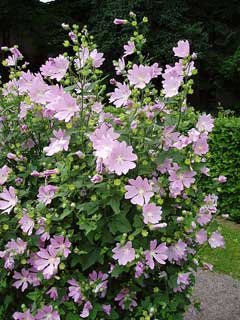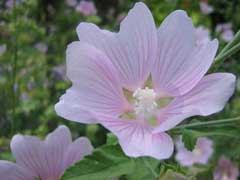 |
|
http://commons.wikimedia.org/wiki/User:Nordelch |
 |
| http://de.wikipedia.org/wiki/Benutzer:Botaurus |
Translate this page:
Summary
Physical Characteristics

 Lavatera thuringiaca is a PERENNIAL growing to 1.8 m (6ft) by 1 m (3ft 3in) at a fast rate.
Lavatera thuringiaca is a PERENNIAL growing to 1.8 m (6ft) by 1 m (3ft 3in) at a fast rate.
See above for USDA hardiness. It is hardy to UK zone 8 and is not frost tender. The species is hermaphrodite (has both male and female organs) and is pollinated by Insects.
Suitable for: light (sandy), medium (loamy) and heavy (clay) soils and prefers well-drained soil. Suitable pH: mildly acid, neutral and basic (mildly alkaline) soils. It cannot grow in the shade. It prefers dry or moist soil. The plant can tolerate maritime exposure.
UK Hardiness Map
US Hardiness Map
Synonyms
L. olbia. Hort.
Plant Habitats
Woodland Garden Sunny Edge;
Edible Uses
Edible Parts: Flowers Leaves
Edible Uses:
Young leaves - raw or cooked. A mild flavour, but the leaves are tough and not very worthwhile[K]. Leaves of the cultivar 'Barnsley' are less tough and are reasonably tasty, a plant at Kew had also produced quite a few leaves in the winter and so it is a potential winter salad[K]. Flowers - raw. A pleasant mild flavour, they make a decorative addition to the salad bowl[K]. Many named cultivars have considerably larger flowers than the type species and are thus much more worthwhile for the salad bowl[K].
References More on Edible Uses
Medicinal Uses
Plants For A Future can not take any responsibility for any adverse effects from the use of plants. Always seek advice from a professional before using a plant medicinally.
None known
References More on Medicinal Uses
The Bookshop: Edible Plant Books
Our Latest books on Perennial Plants For Food Forests and Permaculture Gardens in paperback or digital formats.

Edible Tropical Plants
Food Forest Plants for Hotter Conditions: 250+ Plants For Tropical Food Forests & Permaculture Gardens.
More

Edible Temperate Plants
Plants for Your Food Forest: 500 Plants for Temperate Food Forests & Permaculture Gardens.
More

More Books
PFAF have eight books available in paperback and digital formats. Browse the shop for more information.
Shop Now
Other Uses
Fibre
A strong fibre is obtained from the stems, it is used for making string, bags, paper etc[74].
Special Uses
References More on Other Uses
Cultivation details
An easily grown plant, succeeding in any ordinary garden soil[1]. Prefers a light well-drained moderately fertile soil in full sun[200]. A soil that is too rich encourages foliar growth at the expense of flowering[200]. Tolerates maritime exposure[200]. Plants are hardy to about -20°c[187]. There are many named forms selected for their ornamental value[200]. The cultivar 'Barnsley' usually produces new shoots from the base in the autumn and winter. It is therefore a potential winter salad plant, though the texture of the leaves is not that wonderful[K].
References Carbon Farming Information and Carbon Sequestration Information
Temperature Converter
Type a value in the Celsius field to convert the value to Fahrenheit:
Fahrenheit:
The PFAF Bookshop
Plants For A Future have a number of books available in paperback and digital form. Book titles include Edible Plants, Edible Perennials, Edible Trees,Edible Shrubs, Woodland Gardening, and Temperate Food Forest Plants. Our new book is Food Forest Plants For Hotter Conditions (Tropical and Sub-Tropical).
Shop Now
Plant Propagation
Seed - sow spring in a cold frame and only just cover the seed[200]. Germination is usually quick and good. Prick out the seedlings into individual pots when they are large enough to handle and plant them out in early summer[K]. Basal cuttings in spring. Cuttings of softwood in June/July[188].
Other Names
If available other names are mentioned here
Native Range
Coming Soon
Weed Potential
Right plant wrong place. We are currently updating this section.
Please note that a plant may be invasive in one area but may not in your area so it's worth checking.
Conservation Status
IUCN Red List of Threatened Plants Status :

Growth: S = slow M = medium F = fast. Soil: L = light (sandy) M = medium H = heavy (clay). pH: A = acid N = neutral B = basic (alkaline). Shade: F = full shade S = semi-shade N = no shade. Moisture: D = dry M = Moist We = wet Wa = water.
Now available:
Food Forest Plants for Mediterranean Conditions
350+ Perennial Plants For Mediterranean and Drier Food Forests and Permaculture Gardens.
[Paperback and eBook]
This is the third in Plants For A Future's series of plant guides for food forests tailored to
specific climate zones. Following volumes on temperate and tropical ecosystems, this book focuses
on species suited to Mediterranean conditions—regions with hot, dry summers and cool, wet winters,
often facing the added challenge of climate change.
Read More
Expert comment
Author
L.
Botanical References
50200
Links / References
For a list of references used on this page please go here
Readers comment
© 2010, Plants For A Future. Plants For A Future is a charitable company limited by guarantee, registered in England and Wales. Charity No. 1057719, Company No. 3204567.